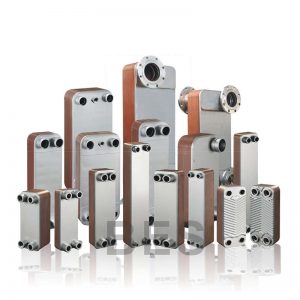
Regarding the replacement steps and precautions for plate heat exchanger freezing and cracking, in order to ensure that the plate replacement on site meets the requirements, to ensure the quality of the replacement process, and to prevent the problem of plate replacement east cracking again after replacement, maintenance personnel are required to repair the plate replacement freeze crack unit Strictly follow the following steps to detect, replace and install, and pay attention to the inspection and repair of the air conditioning water system and the protection device of the unit itself
1. The system components that need to be replaced after the board is replaced and frozen
After the plate is frozen and cracked, water will enter the entire air conditioning system under normal circumstances, which will generally cause the compressor, filter drier, plate heat exchanger, etc. to fail. These three components must be replaced; at the same time, the vapor and liquid in the system A large amount of water may accumulate in separators, liquid storage tanks, finned condensers, and pipelines, which need to be removed and dried during maintenance.
2. Replacement and installation steps of repair parts
1. Clean the water in the air conditioning water system;
2. Replace the failed compressor, plate heat exchanger, filter drier, etc.;
3. Cleaning system pipelines, finned condensers, vapor-liquid separators, liquid storage tanks, throttling devices and other components in the R22 system; (the sediment in the water system may enter a small amount due to the rupture of the plate heat exchanger System, so we must clean the system during maintenance to ensure the cleanliness of the system)
4. Drying system piping, fin condenser, vapor-liquid separator, liquid storage tank, throttling device and other R22 system components;
5. Weld and reduce the diameter of the plate heat exchanger;
6. Weld the compressor, plate heat exchanger and filter dryer to the system;
7. Leak detection system;
8. Vacuum;
9. Fill the system with refrigerant according to the nameplate;
10. After the water system is filled with water, check whether the components of the unit are normal;
11. Then test run and check the operating status of the unit.
3. Treatment of water system
Before refilling the air conditioning water system, please clean the system pipes to ensure that there are no impurities such as sand, oil, etc. in the water system.
4. Matters needing attention during inspection, maintenance and installation
1. Check whether a Y-type water filter is installed before the water inlet of the unit, whether the filter screen of the Y-type water overspeeder is 50 mesh, whether the filter is installed tightly, whether there is damage, and the filter installation position is as close as possible to the water inlet of the unit ; Y-type water filter must be installed;
2. Check whether the water flow switch is operating normally. Normally, the water flow switch can only be turned on after the water pump is turned on; when the water pump is stopped, the water flow switch is turned off, and the entire unit stops running; in addition, when the flow switch is adjusted, the general action value is : When the standard water flow is below 60%-70%, the flow switch is off, and when the flow is 80%-90% of the standard, the flow switch is on.
3. Before turning on the unit, please check whether the setting of the inlet water temperature point and the antifreeze protection temperature point are correct, the inlet water temperature is set to 12℃, and the antifreeze protection temperature is 5℃;
4. The vacuum pressure of the system is 90-130PA. The vacuum time must be ensured to avoid dry and residual moisture in the system. It is best to ensure that the required vacuum pressure is pumped to continue pumping for 12 hours, and then keep the pressure for 12 hours. To ensure that there is no water in the system (including vapor separation and liquid storage tanks);
5. The unit starts trial operation, the inspection rules of each parameter point, under standard working conditions:
The ambient temperature is 35°C, the inlet and outlet water temperature is 12°C/7°C, and the compressor suction temperature of the unit is generally around 8°C/85C under the standard water flow, the suction pressure is above 4BAR, and the high pressure is around 18-19BAR; Pay special attention to the suction pressure during the trial operation. Even when the minimum refrigeration outdoor ambient temperature is 21℃, the suction pressure should be above 3.8BAR; if the pressure is too low and the return temperature is too low, you should check:
a. Whether the throttling device is normal;
b. Whether the water flow is within the standard flow range;
c. Whether the system refrigerant is charged according to the nameplate;
d. Whether the inlet and outlet water temperature of the unit is normal;
e. Whether the plate heat exchanger is partially blocked.
6. When installing the compressor, when the compressor rubber plug is opened, it is best to install it into the system within 30 minutes; the dryer filter should be installed last, and the protective cover should be installed immediately after the opening;
7. When welding the entire system, there must be nitrogen-filled protective welding; when welding plate heat exchangers, water cooling protection must be performed on the plate heat exchanger to avoid welding damage to the plate heat exchanger;
8. Check whether the low-pressure switch of the single-cooling unit is above 2BAR;
9. Check whether the water temperature probe is normal, whether it is damaged, and whether it is installed at the outlet of the plate heat exchanger;
10. The filter screen of the Y-type water filter must be cleaned and inspected regularly;
11. Check whether the water quality of the water in the air conditioning water system meets the requirements, whether there are impurities, and whether the other pH meets the requirements of the unit.
